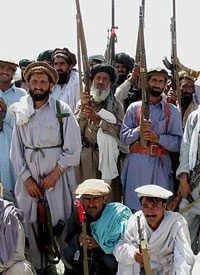
Operating on both sides of the border, the terrorists have raided and even established control over some villages in the FATA, and have also launched raids against U.S. and Afghani military units across the border. During the past four years, the Taliban have killed as many as 500 tribal elders, but the ongoing violence has escalated into an all-out war in the past two months, as the insurgent forces transplanted from Afghanistan have burned the homes of tribal leaders and assassinated their opponents.
Under the plan, Pakistani officials would provide arms, including AK-47 rifles to members of local militias, known as lashkars. Operating in the region are an estimated 25,000 lashkars, who have organized to resist the Taliban incursion.
The International Herald Tribune interviewed Abdul Rehman, a tribal leader of the Orakzai area, as he lay on his bed in the Lady Reading hospital in Peshawar, Northwest Pakistan’s principal city. Rehman explained his reason for helping to form a militia: “We wanted to form a lashkar,” said Rehman. “We were pressured by the government to take action because they warned, ‘If you don’t take action you will be bombed.’”
A Pakistani general explained his government’s strategy to the Tribune: “We’re concentrating on the hard core [enemy fighters]; the lashkars are cleansing their areas, taking people out in their areas.”
BBC News has reported that Pakistan has deployed 180,000 members of its security forces in the tribal areas for the last seven years, but they have been unable to control the militants. reportedly numbering a few thousand, who operate there.
Pentagon spokesman Bryan Whitman, who was quoted by Reuters news service, said he had no details of the plan. “What’s important here is that Pakistan, the Pakistan government, recognizes that they have a challenge with extremists inside their own country and clearly they are looking for a variety of means … to address it," said Whitman.
Pentagon officials said the plan was similar to plans advocated by senior U.S. military officers for some time. “The concept is welcome,” said one senior military official.
Two Pakistani officials, speaking on condition of anonymity, said that the United States would not play a part in developing, funding, or implementing the militia plan. One official said: “This is an initiative of the tribesmen themselves and the new government. The tribesmen are tired of the militants, want them out of their areas and the government is helping.”
Pakistan has been under U.S. pressure to gain control over the lawless tribal region that provides safe havens for the Taliban, al-Qaeda, and other militant groups. The United States has stepped up operations in the border area, and has fired missiles from unmanned drones into areas where suspected militants have hidden. Some U.S. operations have come close enough to the Pakistan border to elicit a negative response from the Pakistanis, who are considered our allies against the terrorists. The New York Daily News reported on September 25: “Pakistan troops fired on a pair of U.S. helicopters before swapping gunfire with American ground forces Thursday in a five-minute confrontation on the Afghanistan-Pakistan border. The OH-58 reconnaissance choppers, known as Kiowas, were not hit by the small arms fire and no injuries were reported in the brief skirmish.”
U.S. and Pakistani officials disagreed concerning which side of the border the U.S. helicopters were on, with the United States insisting they were over Afghanistan. But when Pakistani President Asif Ali Zardari was in New York for a meeting with Secretary of State Rice, he insisted his military only fired only warning flares — not shots — into the sky, as a signal to the U.S. helicopters that they had strayed into Pakistani airspace. “Sometimes the border is so mixed that they don’t realize they crossed,” said Zardari. Secretary Rice agreed, saying, “The border is very, very unclear.”



